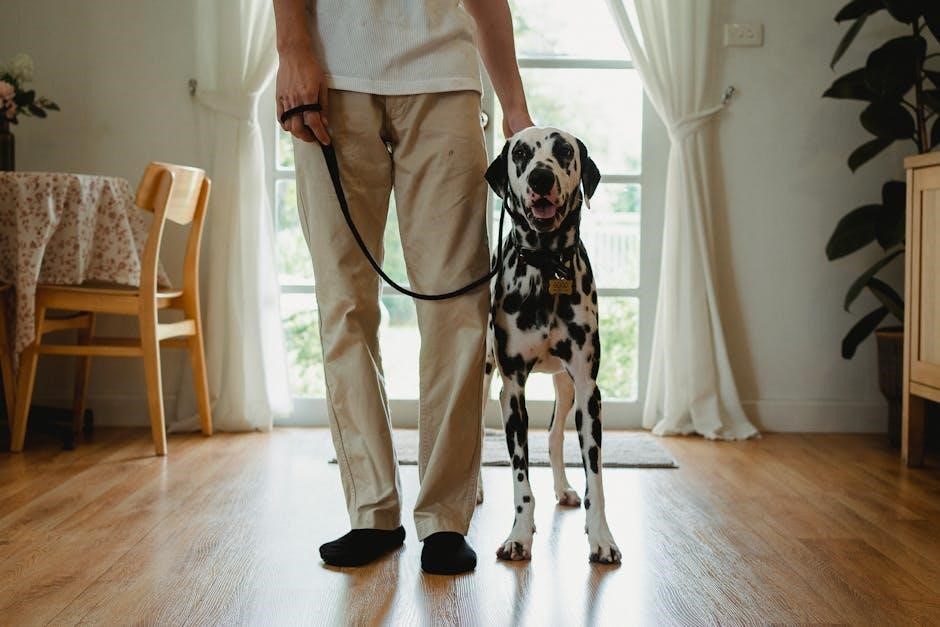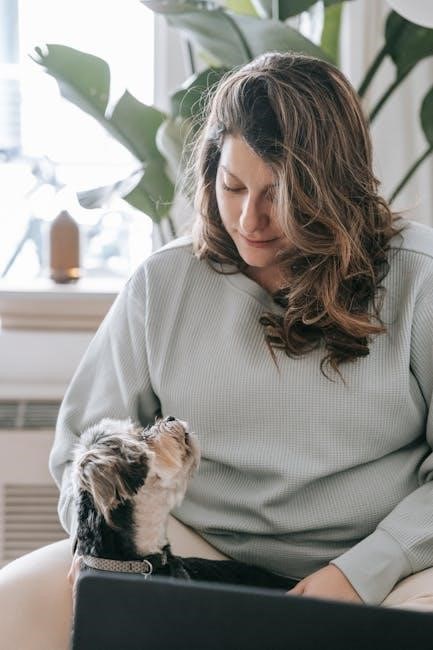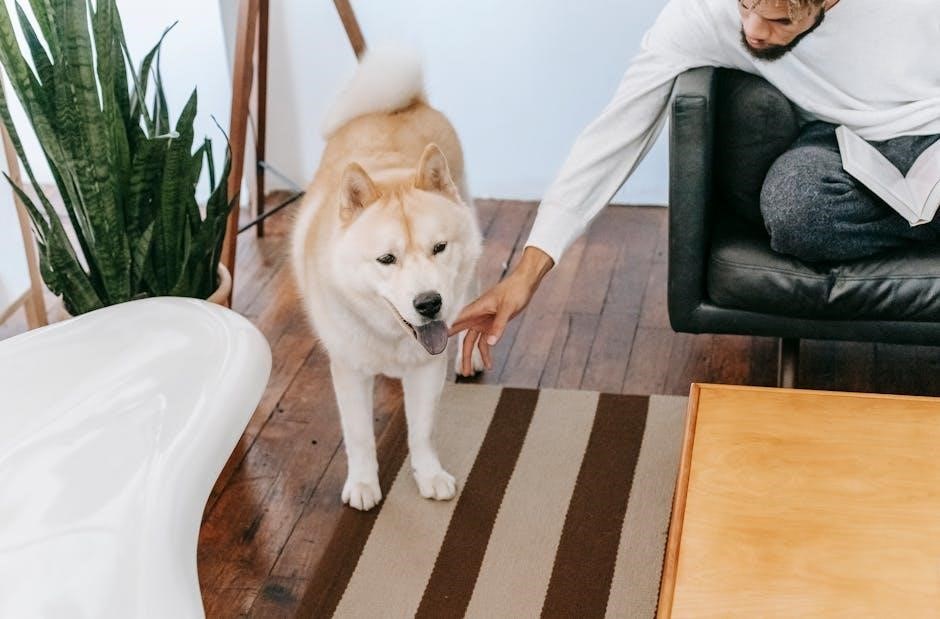Welcome to the Pet-Friendly Plant Guide‚ your ultimate resource for creating a safe and beautiful environment for both your pets and plants; As a pet owner‚ it’s essential to know which plants are toxic and which are safe for your furry friends. This guide helps you make informed choices‚ ensuring your home remains hazard-free while still enjoying the beauty of nature indoors and outdoors.
Whether you’re a dog or cat owner‚ understanding the risks posed by certain plants is crucial. By learning which species are harmful and which are non-toxic‚ you can create a harmonious space where your pets and plants coexist peacefully. This guide also offers tips for protecting your pets and provides a list of popular pet-safe plants to enrich your garden or home.
With this guide‚ you’ll gain the knowledge to identify toxic plants‚ explore safe alternatives‚ and take proactive steps to safeguard your pets. Let’s embark on this journey to responsible plant parenting together!

Understanding the Importance of Pet-Safe Plants
Choosing pet-safe plants is crucial for ensuring the well-being of your furry friends. Many common houseplants‚ like lilies and sago palms‚ contain toxins that can severely harm cats and dogs. Even small amounts of ingested plant material can lead to serious health issues‚ including organ damage or even failure in severe cases. By selecting non-toxic plants‚ you create a safer environment for your pets to thrive. This guide helps you identify harmful species and offers alternatives‚ ensuring your home remains both beautiful and hazard-free for your beloved companions.
Toxic Plants for Pets
Toxic plants pose serious risks to pets‚ causing symptoms ranging from mild illness to life-threatening conditions. Common culprits include lilies‚ sago palms‚ dieffenbachia‚ and tulips‚ which can harm cats and dogs if ingested.
Plants Toxic to Dogs
Several plants are highly toxic to dogs‚ causing severe health issues if ingested. Sago palms‚ lilies‚ and tulips are particularly dangerous‚ as they can lead to organ failure or other serious complications. Other harmful plants include azaleas‚ rhododendrons‚ and daffodils‚ which can cause vomiting‚ diarrhea‚ and heart problems. Even small amounts of these plants can be toxic‚ so it’s crucial to keep them out of reach. Always double-check the safety of any plant before bringing it into your home to protect your furry friends.
Plants Toxic to Cats
Cats are particularly vulnerable to certain plants‚ with lilies being among the most toxic. Even small amounts of lily pollen or leaves can cause severe kidney damage. Other harmful plants include sago palms‚ castor beans‚ and oleander‚ which can lead to liver failure or heart issues. Symptoms of plant poisoning in cats often include vomiting‚ lethargy‚ and loss of appetite. If you suspect your cat has ingested a toxic plant‚ seek veterinary care immediately to prevent life-threatening complications. Always verify the safety of plants before introducing them to your home.
Common Houseplants That Are Harmful to Pets
Several popular houseplants pose significant risks to pets; Lilies‚ for instance‚ are highly toxic to cats‚ with even small amounts causing severe kidney damage. Sago palms‚ peace lilies‚ and snake plants also contain toxins that can harm both cats and dogs. Ingestion of these plants often leads to symptoms like vomiting‚ diarrhea‚ and lethargy. Some plants‚ like castor beans and oleander‚ can cause life-threatening complications. It’s crucial for pet owners to identify and avoid these harmful plants to ensure their pets’ safety and well-being at home.
Non-Toxic Plants for Pets
Non-toxic plants are a wonderful way to bring life and beauty into your home while keeping your pets safe. Spider plants‚ Calathea‚ and palm varieties are excellent choices‚ as they are harmless to both cats and dogs. Additionally‚ plants like the String of Hearts and prayer plants are pet-safe and add a decorative touch. Always double-check the toxicity of any plant before bringing it home‚ using reliable sources like the ASPCA’s plant list. This ensures your space remains safe and enjoyable for all family members‚ including your furry ones.
Pet-Safe Houseplants
Pet-safe houseplants are a great way to enhance your home’s beauty while ensuring your furry friends remain healthy. Spider plants‚ Calathea‚ and various palm species are excellent choices‚ as they are non-toxic to both cats and dogs. These plants are not only aesthetically pleasing but also easy to care for‚ making them perfect for busy pet owners. Additionally‚ prayer plants and the String of Hearts are popular options that add vibrancy to your space without posing a risk to your pets.
Always double-check the toxicity of any plant before bringing it home‚ using reliable sources like the ASPCA’s plant list. This ensures your space remains safe and enjoyable for all family members‚ including your furry ones. With the right choices‚ you can create a harmonious and pet-friendly indoor garden.
Dog-Safe Garden Plants
Dog-safe garden plants allow you to create a beautiful outdoor space where your furry friends can play freely. Sunflowers‚ zinnias‚ and daisies are excellent choices‚ as they are non-toxic to dogs. These plants add color and vibrancy to your garden while ensuring your pets’ safety. Additionally‚ marigolds and certain grasses are great options for dog-friendly landscaping. Always verify the toxicity of any plant before planting to protect your dogs from potential harm.

Popular Pet-Friendly Plants
Popular pet-friendly plants like Calathea‚ Spider Plants‚ and Palm varieties add beauty to your space while ensuring your pets’ safety. These plants are visually appealing‚ low-maintenance‚ and non-toxic.
Calathea‚ Spider Plants‚ and Palm Varieties
Calathea‚ Spider Plants‚ and Palm varieties are excellent choices for pet-friendly spaces. Calathea‚ known for its vibrant foliage‚ is safe for both dogs and cats. Spider Plants are easy to care for and non-toxic‚ making them perfect for indoor hanging baskets. Palm varieties like Parlor and Areca Palms add tropical charm without posing risks. These plants are not only visually stunning but also create a welcoming environment for your pets to thrive in safely.
String of Hearts and Other Safe Options
The String of Hearts (Ceropegia woodii) is a charming‚ low-maintenance plant that’s perfect for pet-friendly spaces. Its trailing stems and heart-shaped leaves add visual interest without posing risks to your pets. Other safe options include Peperomia‚ a small‚ stylish plant with beautiful foliage‚ and the ZZ Plant‚ known for its resilience and non-toxic properties. These plants are ideal for indoor spaces‚ offering both aesthetic appeal and peace of mind for pet owners. They thrive in various lighting conditions and require minimal care‚ making them great additions to any home.

How to Identify Toxic Plants
Identifying toxic plants is crucial for pet safety. Consult the ASPCA’s toxic plant list and check for scientific names. Plants like lilies and sago palms are highly toxic. Always verify symptoms and cross-reference before bringing any plant home.
Recognizing Common Toxic Plant Species
Recognizing toxic plants is vital for pet safety. Common species like lilies‚ sago palms‚ and azaleas are highly toxic to pets. Lilies can cause severe kidney damage in cats‚ while sago palms contain cycasin‚ which is toxic to both dogs and cats. Plants like tulips and daffodils also pose risks‚ as their bulbs can be harmful. Dieffenbachia and Philodendron are toxic to dogs‚ causing oral and gastrointestinal irritation. Always verify the scientific names‚ as they are more reliable than common names. Use resources like the ASPCA’s toxic plant list for accurate identification.
Using Plant Lists for Safe Selection
Using plant lists is essential for safe selection when sharing your space with pets. Reliable sources like the ASPCA provide comprehensive lists of toxic and non-toxic plants. These lists help identify harmful species‚ such as lilies‚ sago palms‚ and tulips‚ which can be deadly to cats and dogs. They also highlight safe options like spider plants and calatheas. Always cross-reference plant names‚ as common names can vary. By consulting these lists‚ you can make informed decisions‚ ensuring your home remains pet-friendly while still enjoying the beauty of plants.

Protecting Pets from Harmful Plants
Safeguard your pets by keeping toxic plants out of reach. Use plant lists to identify harmful species and opt for pet-safe alternatives. Train your pets to avoid certain areas‚ and consider using bitter-tasting sprays to deter nibbling. Supervise outdoor exploration and teach your pets to leave plants alone. These steps create a safer‚ pet-friendly environment while enjoying the beauty of nature.
Tips for Keeping Pets Away from Toxic Plants
Tips for Keeping Pets Away from Toxic Plants
To keep pets safe‚ move toxic plants out of reach or replace them with pet-safe alternatives. Use bitter-tasting sprays to deter nibbling. Supervise outdoor exploration‚ especially around harmful plants like lilies or sago palms. Train pets to avoid certain areas and provide plenty of toys to distract them from plants. Regularly inspect your garden or indoor space for hazardous species. Educate family and guests about toxic plants to ensure everyone contributes to your pet’s safety. These proactive steps help create a secure environment for your furry friends.
Creating a Pet-Friendly Garden
Designing a pet-friendly garden involves thoughtful plant selection and layout. Choose non-toxic plants like sunflowers‚ Calathea‚ or Spider Plants to ensure your garden is safe. Avoid harmful species such as lilies or sago palms. Use physical barriers to prevent access to toxic plants if they’re already present. Ensure your garden is escape-proof to protect curious pets from neighboring hazards. Incorporate open spaces for play and shade for comfort‚ creating a haven where your pets can thrive alongside nature. This approach balances beauty and safety for a harmonious outdoor space.
First Aid for Pet Plant Poisoning
If your pet ingests a toxic plant‚ stay calm and act quickly. Contact the ASPCA Animal Poison Control Center at (888) 426-4435 for immediate advice. Identify the plant consumed and follow professional guidance to ensure your pet receives timely care.
What to Do If Your Pet Ingests a Toxic Plant
Stay calm and act quickly if your pet ingests a toxic plant. Immediately identify the plant consumed and contact the ASPCA Animal Poison Control Center at (888) 426-4435 for guidance. Do not induce vomiting unless instructed by a professional. Provide detailed information about the plant and your pet’s symptoms. Seek veterinary care promptly‚ as early treatment is crucial. Monitor your pet closely for any signs of distress‚ such as vomiting‚ drooling‚ or lethargy. Swift action can significantly improve your pet’s outcome in a poisoning emergency.
Emergency Contact Information
In case of a plant poisoning emergency‚ contact the ASPCA Animal Poison Control Center at (888) 426-4435 for immediate assistance. Another vital resource is the Pet Poison Helpline at (855) 213-6680. Both services provide expert advice and can guide you through the next steps. Keep these numbers handy to ensure quick action if your pet ingests a toxic plant. Always consult a veterinarian or a poison control hotline before taking any measures to help your pet.